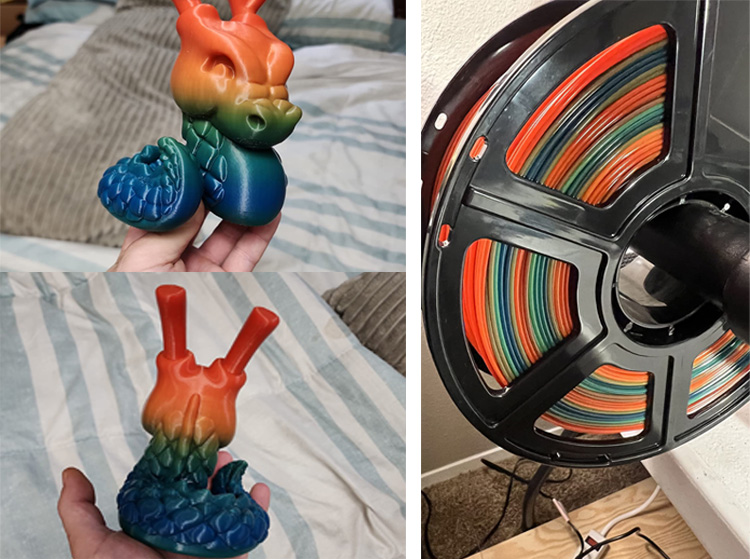Filament, in its literal meaning, is a long thread-like object, e.g., the electrical filament in a light bulb. While what is filament for 3D printer? Firstly we should know that a 3D printer is a device of addictive manufacturing and to manufacture something out we need feed the 3D printer device with consumables. A 3D printer is to consumables just like a car is to petrol. We feed a car with petrol so that it runs, and we feed a 3D printer with consumables so that it builds new objects. 3D printer filament is among those various kinds of 3D printing consumables. It’s not the exact thing as electrical filament, but a thread-like structure of thermoplastic normally call as “filament” by 3D printer users.
▲Filament and 3D printer filament
What's filalent for 3D printer
Standard products of 3D printer filament are often packaged in a little box, with the long plastic filament winding around a steel reel. Insert the end of 3D printer filament into the feed port of the 3D printer, tap “start printing” on 3D printer’s touchscreen, it will starting build 3D object. 3D printers that can use multiple filaments are typically more expensive than those that can only use one type of filament.
▲Filament inserted into feeding port of the 3D printer
Filament 3D printer
3D printers feeding on thermoplastic filament are called filament 3D printer. Actually such printer is formally called FDM 3D printer, which makes use of FDM (Fused Deposit Modelling) 3D printing technology. To interpret it simply, Fused Deposit Modelling is such a technology that making thermoplastic filament melted under certain temperature(generally 180-250℃) and then extruding the liquid filament to build 3D models. It’s the extruder assembly of the FDM 3D printer that plays this role.
▲Filament 3D printer (Left: Open style; right: Enclosed style)
Filament 3D printer is the most commonly used printer type by personal consumers, due to low cost, lightweight, desktop design, and environmental safety. People who are interested in 3D printing usually start from filament 3D printer. Enjoy happiness of successful 3D printing work on a filament 3D printer. See how 3D prints make you shine!
▲Enjoyable 3D print life
However, not all 3D printers feed on filament. In other words, not all 3D printers are of FDM 3D printing technology. Different raw materials (consumables) have different material properties and require different printing technologies. If classify 3D printers by the consumables they are fed on, then there are filament 3D printer, resin 3D printer, wax 3D printer, metal 3D printer, and others.
3D printer filament types
Back to filament 3D printers! Thermal plastic material as 3D printer filament is, there are various thermal plastic types so that 3D printing material producers have developed various types of 3D printer filaments, including PLA filament, ABS filament, TPU filament, PETG filament, PA filament, and other composite filament. They varies in physical strength, flexibility, durability, shrinkage rate, etc.
You can decide which filament to use based on what application scenes of your 3D printed objects. If you need print a strong part with flexibility (a mobile phone case or a RC-car tire), you can use the filament made of TPU plastic. If your 3D printer is the enclosed type and with heatable print bed, you can also select ABS filament for such cases. If you have no much demand on toughness, strength and pressure tolerance of the part/model (like, you just want to build a beautiful physical model), then use PLA filament, which is less expensive and prints faster. PETG filament can be treated as an premium alternative of PLA filament.
Which type of 3D printer filament to choose is also subjected to your filament 3D printer type. Sometimes, you cannot successfully print ABS filament on your 3D printer because that 3D printer is incapable to meet the extruder temperature (230℃-250℃) and without enclosed warm chamber! Your 3D printer just don’t allow it! Nevertheless, don’t be scared away! What types of filament you can use is often described clearly on the product manual or on the product sale page! Having this mindset before purchasing a 3D printer filament helps a lot! How to Choose Proper Filament for Your 3D Printer? Different filament types enrich your 3D print life!
▲Dragon printed by rainbow 3D printer filament
How to select the best filament for 3D printer
Both called filament product, why some have various printing problems (such as easy breakage, plugging 3D printer nozzles), while other filament products have a good reputation, with printing going smooth and finishing good results? The root cause is the production processing of 3D printer filament . Different manufacturers use different processing formula for filament production. Just like making crabcakes, the taste in each restaurant differ due to different recipes. So how to select the best 3D printer filament?
Packaging issues. 3D printer filament products are with sealed packages to prevent moisture. So, first check whether the package is leaking.
Observing the color. Except filaments of gradient colors, others are monochrome. Please check whether there is color difference on the filament surface. Whether the color is uniformly distributed.
Impurity spots. If the 3D printer filaments are not well disposed during processing, there would be speckled impurities on the filament surface.
Diameter accuracy of the filament. There are generally two diameter specifications of filament for FDM3D printers, one is 2.85mm in diameter and the other is 1.75mm in diameter. There is no properties difference between the two, but some 3D printer structures require thicker filaments. The most common is the 1.75mm.
▲Testing diameter of a dual-color PLA filament
Accurate diameter ensures accurate flow of melted filament. Filament diameter being too small, it is prone to insufficient extruding, or even failed printing. Filament diameter being too large, it is prone to overflow on the surface of the model.
Testing print effect. When printing the first layer, you should pay attention to whether the extruded filament is uniform; and whether there are air bubbles during the printing process. Check the print effect after printing, whether the model surface is smooth, precisely printed, or no layer leaking. Remember not to frequently change your filament type, otherwise the 3D printer units will be easily blocked.
Write in the end
There are many ways of purchasing, whether offline or online. You can go to a physical store where the filament for 3D printers is directly accessible, or you can visit online stores specialized on 3D printer and 3D printer filaments. In such a case, you’re suggested to browse the comment area of the product page, finding related descriptions and decide which is the best filament to purchase.
People read this article also read:
How to Choose Proper Filament for Your 3D Printer?
Really useful review on 3D printer filament types and uses










